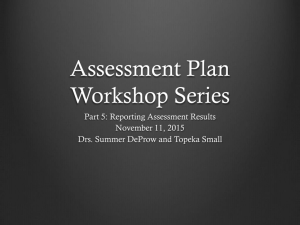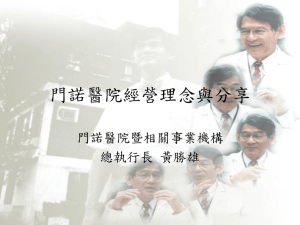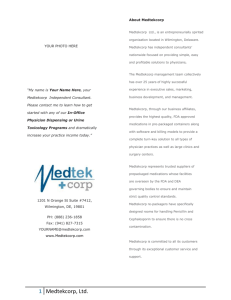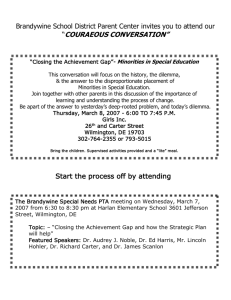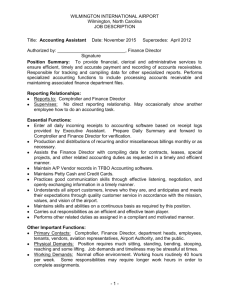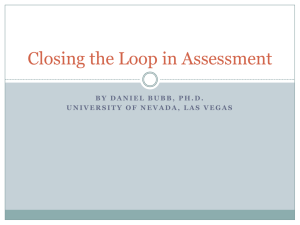Workshop Files
advertisement
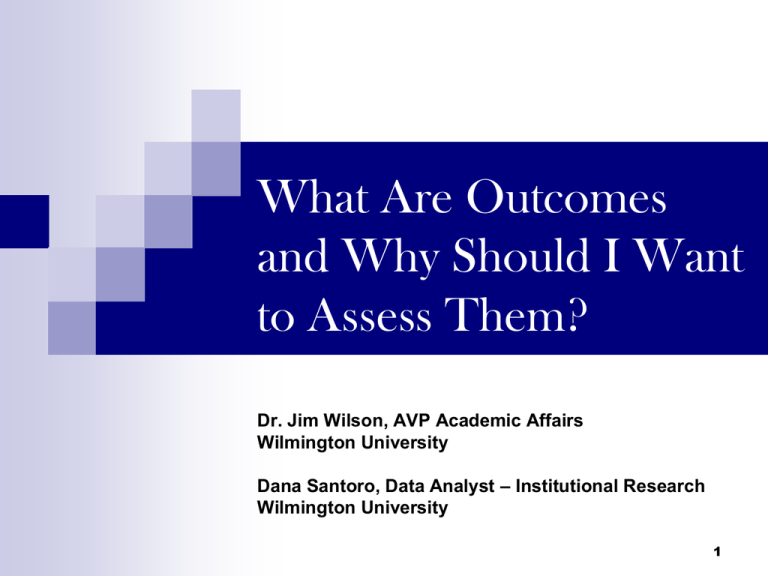
What Are Outcomes and Why Should I Want to Assess Them? Dr. Jim Wilson, AVP Academic Affairs Wilmington University Dana Santoro, Data Analyst – Institutional Research Wilmington University 1 Class of 2011 What Berlin wall? They never “rolled down” a car window They have grown up with bottled water Wal-mart has always been a larger retailer than Sears and has always employed more workers than GM High definition televisions have always been available China has always been more interested in making money than in re-education They never saw Johnny Carson live on television Food packaging has always included nutritional labeling Courtesy of Beloit College Public Affairs 2 Things Have Changed! Higher Education Research Institute (HERI) UCLA 40yr Trends Presentation 3 Things Have Changed! Item 1970 1995 Today Postage Stamp $0.06 $0.32 $0.39 Bread $0.24 $1.40 $1.39 Milk $1.32 $2.59 $4.29 Gas $0.40 $1.35 $2.60 Car $2,500.00 $12,800.00 $27,800.00 Income $6,933.00 $19,717.00 $43,200.00 House $40,000.00 $111,000.00 $264,000.00 4 Education: Costs Wilmington University Tuition 30 credits, Undergraduate 1971 Full year tuition: $1,500 Today Full year tuition: $8,400 (New Castle, UG) 5 Education: Some Changes Today Student-centered learning The “Net Generation” Distance Learning, Online databases 1967 Teacher-centered learning Classroom, Books, Library card catalogs Al Gore was only 20 years old Courtesy of Beloit College Public Affairs 6 Education: Student Learning A new “paradigm for higher education” (Suskie, 2006.) Learning Centered Assessment feedback helps faculty understand What is and is not working effectively How to improve the curriculum as well as teaching and learning strategies 7 Wilmington University Mission 8 What is Assessment of Student Learning? “Good assessment must begin in the classroom and end there.” (Wolvord & Anderson, 1998, p. 149) 9 What is Assessment of Student Learning? “Systematically gathering, analyzing, and interpreting evidence to determine how well student learning matches our expectations.” (Suskie, 2006, p.3.) 10 What is Assessment of Student Learning? “Assessment is first and foremost a tool for faculty members to use as they do their very best to teach their students well.” (Middle States, 2003) 11 Assessment Is A Friend Who… Honestly tells us how we are doing Helps to clarify what we are doing and why Helps us to make informed decisions Improves student learning Helps us to improve Brags about how well we are doing 12 Assessment Could Be a Foe! Federal requirements Regional Accreditation Legislators Parents and Community groups Students Professional organizations 13 Summary What is Assessment of Student Learning? Process of gathering & evaluating information Quantitative and qualitative From multiple sources To enhance student learning 14 Student Outcomes Assessment Framework 15 Three Assessment Areas Student Learning Teaching Effectiveness Student satisfaction with their academic experience 16 Wilmington University ACADEMIC AFFAIRS ASSESSMENT PLAN COLLEGE MISSION Assessment of Teaching Effectiveness Assessment of Student Learning Outcomes Graduation Competencies Benchmarks Benchmarks Division / Program Mission Professional Standards -------- PROGRAM COMPETENCIES • IDEA Results • Faculty Evaluations • GPA Reports • Enrollment Data •ACT Survey Results Benchmarks License & Certification Exams College Outcomes Course Work Major Field Exams CECRAM Rubrics, Test Embedded Questions, Clinical Evaluations Data Collection, Analysis, Reporting, Decisions,Actions 17 Program Improvement Cycle 18 Language of Assessment Direct evidence Direct evidence of student learning indicates whether or not a student has a command of specific content Examples: Homework assignments, research papers, rubrics CECRAM (Course-Embedded CriterionReferenced Assessment Measures) 19 Language of Assessment Indirect Evidence Indirect evidence of student learning is correlational – data exists which indicates that students are probably learning. Examples: Course grades, time spent on service learning or homework 20 Language of Assessment Formative assessment Ongoing assessment that is intended to improve an individual student’s performance. Purpose: to improve course content, provide feedback to faculty. 21 Language of Assessment Summative assessment Provides a true gauge of “outcomes” of student learning. Data is typically gathered near the end of program completion Examples: course-embedded project/test/portfolio, clinical evaluations, standardized exams 22 WU Language “Good enough” The process is accurate and truthful (Suskie, 2004, p. 302) “Closing the loop” Outcomes data has been analyzed and appropriate changes have been made. 23 Elements of Assessing Learning 1. 2. 3. 4. Articulated expectation of student learning at various levels. A plan that describes student learning assessment activities. Evidence that student learning assessment information is used. Documented use of student learning assessment as a part of institutional assessment. 24 Background Information Academic Affairs Assessment Plan adopted in 2003 Plan called for evaluation in 2006 25 MSCHE Outcomes Assessment Guidelines Assessment should be: Useful Cost-effective, simple Reasonably accurate and truthful Organized, systematized and sustained. Suskie, L. (2005) 26 Major Changes Related to Outcomes Assessment Five Year Data Collection and Implementation Cycle Revision of Graduation Competencies Representative Sampling Formal Reporting Cycle Five Year Program Review 27 How to maintain momentum? A 5 year cycle will be utilized Year 1 – Implement findings from program review Year 2 – Data collection Year 3 – Reflection, take appropriate action and collect “other kinds” of data Year 4 – Data collection Year 5 – Program Review Report 28 What are Examples? (of closing the loop) Program: B.S., Finance Weakness: Undergraduate Finance majors were missing some important finance skills Source: ETS Major Field Exam Action Adjust the content of FIN 305 Add a new requirement, FIN 306 Competency Disciplined Inquiry Finance program competencies 29 What are Examples? (of closing the loop) Program: All UG Education programs Weakness: Students were unclear of required skills Source: Portfolio review Actions: Curriculum changes Provide candidates with exemplars Ensure understanding of required skills Competency Disciplined inquiry 30 What are Examples? (of closing the loop) Program: M.S., Community Counseling Weakness: Appraisal Techniques Source: CECRAM, CPCE*, NCE* & surveys Response: Integration of assessment with diagnosis and treatment planning. Psychopathology course will precede the appraisal course *Standardized exams 31 What are Examples? (of closing the loop) Program: B.S., Nursing Weakness: Student teaching projects - measurable objectives were not reliably clear Source: CECRAM Actions: content and a teaching video to NUR 425 – Community Health Practitioner Added teaching content to NUR 330 Revised curriculum and developed a new course: NUR 323 - Nurse as Teacher Add 32 Conclusion What is outcomes assessment of student learning? Why should I support the assessment process? 33 References Caffo, Betty, (2003). Striving for Excellence. Faculty Senate Presentation, Wilmington College. Middle States Commission on Higher Education. (2006). Characteristics of excellence in higher education. Philadelphia: Author. Suskie, L. (2004). Assessing student learning: A common sense guide. Bolton, MA: Anker. Walvoord, B.E., and Anderson, V.J. (1998). Effective grading: A tool for learning and assessment. San Francisco, CA: Jossey-Bass. 34
